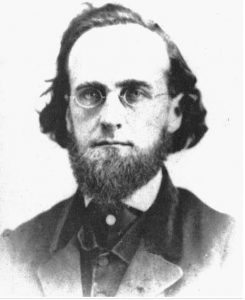(Aug. 24, 1829-Nov. 8, 1885). Nephew and namesake of the famous congressman from Pennsylvania, Thaddeus Merrill Stevens was a lifelong resident of Indianapolis. After attending private schools, he graduated from Indiana Central Medical College in Indianapolis in the early 1850s.
By 1870, Stevens was a professor of toxicology, medical jurisprudence, and chemistry at the Indiana Medical College, and, in 1874, he held the same chair in the College of Physicians and Surgeons. During this same period, he also served briefly as editor of the .
Beginning in the 1870s, Stevens presented a series of influential papers to the State Medical Society on “State Medicine.” He wanted the state to be responsible for the care of those struggling with mental health, preservation of health, the registration of births and deaths, licensure of physicians, and medical education. As a result, the appointed a commission to make recommendations and named Stevens its chairman.
Ultimately, the work of this commission led to legislation establishing the Indiana State Board of Health in March 1881. At the time, Indianapolis was in the middle of a smallpox epidemic, and Stevens, who became the first secretary of that board, had considerable difficulty getting county and town leaders to implement new reporting rules. In the confusion and chaos of getting the new agency off the ground, Stevens also reputedly was handicapped by his lack of people skills and preferred theory to practice. He accused fellow physicians of being “careless and neglectful in the fulfillment of their health duties and obligations” and made enemies of several of the other Board of Health members. In early 1882, the Board threatened to dismiss him unless he changed his ways.
Despite charges that he was “inefficient, careless, lazy and extravagant, and that his records were in such a mess that they were utterly useless,” Stevens managed to organize local health boards, collect reports on epidemics, and send out forms for the registration of births and deaths. He issued the first annual report of the State Board of Health covering nine months from January 1 to September 30, 1882. The report’s 355 pages included tabulated vital statistics—age, sex, occupation, cause of death, as well as births and marriages listed by counties. He was also responsible for making the first sanitary survey of both the state and the city of Indianapolis. He accomplished all of this with only one clerk to assist him.
Board members, whom he had alienated, nevertheless remained determined to replace Stevens. Citing “mismanagement and… incompetency,” its members dismissed him in March 1883. Thereafter, he did not take up a medical practice. He instead operated a medical laboratory and devoted the remainder of his life to his plan to erect public hospitals for the poor across the state with the best medical and surgical practice that the times could afford. In this, he anticipated the public-owned hospitals that dot the state.

Help improve this entry
Contribute information, offer corrections, suggest images.
You can also recommend new entries related to this topic.





